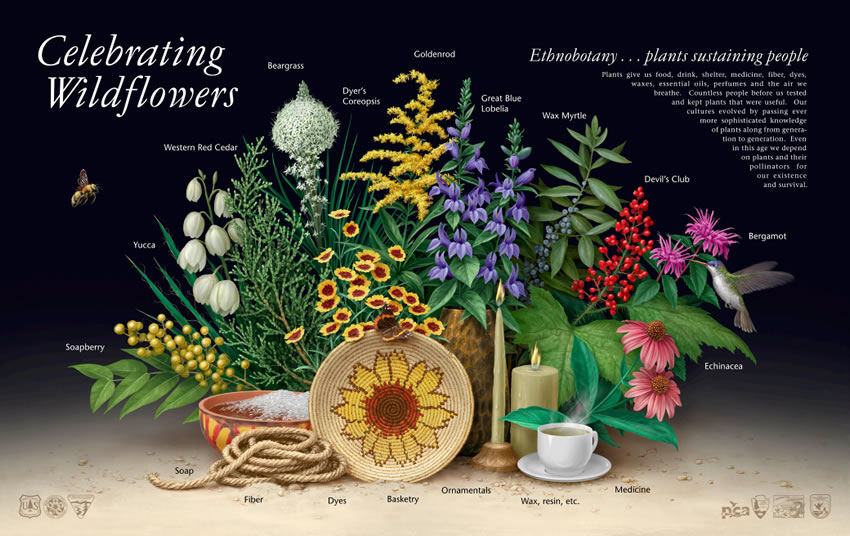More Information
"Ethnobotany…plants sustaining people" Poster
Plants give us food, drink, shelter, medicine, fiber, dyes, waxes, essential oils, perfumes and the air we breathe. Countless people before us tested and kept plants that were useful. Our cultures evolved by passing ever more sophisticated knowledge of plants along from generation to generation. Even in this age we depend on plants and their pollinators for our existence and survival. Art and design by Steve Buchanan.
Related Sites
- Great Lakes Anishinaabe Ethnobotany - The Great Lakes Anishinaabe Ethnobotany site website is a collaboration between the Cedar Tree Institute and the Northern Michigan University Center for Native American Studies both located in Marquette, Michigan, and the USDA Forest Service. The website features video interviews, a collection of personal stories and cultural teachings related to various plants and trees of the upper Great Lakes region.
- Medicine Ways: Traditional Healers and Healing - U.S. National Library of Medicine, National Institutes of Health, Health & Human Services.
- Native American Ethnobotany - A database of foods, drugs, dyes, and fibers of Native American peoples, derived from plants, hosted on the University of Michigan, Dearborn website.
- Wings and Seeds: The Zaagkii Project, A Native Plants and Pollinator Protection Initiative - The Zaagkii Project (Anishinaabe for “The love that comes from the Earth”) is a collaborative effort between the Cedar Tree Institute, the United States Forest Service, and the Keweenaw Bay Indian Community.
- Culturally and Economically Important Nontimber Forest Products of Northern Maine - A USDA Forest Service Northern Research Station Sustaining Forests web page introducing the cultural and ecological landscape of northern Maine and its Canadian neighbors through the non-timber forest products that grow there and the people who gather and depend on them.
Using Cactus as a Bioremediation Tool
 ARS plant/soil scientist Gary Bañuelos (right) and grower John Diener survey prickly pear cactus growing in poor-quality soil.
ARS plant/soil scientist Gary Bañuelos (right) and grower John Diener survey prickly pear cactus growing in poor-quality soil.
The west side of the San Joaquin Valley in California presents several challenges to growers. The soils there include marine sediments, shale formations, and deposits of selenium and other minerals, results of ancient seas and runoff. Anything grown there needs to be irrigated, but the resulting runoff, when it contains high levels of selenium, can be toxic to fish, migratory birds, and other wildlife that drink from waterways and drainage ditches. Periodic droughts and population growth are also squeezing supplies of the fresh water available for irrigation.
Gary Bañuelos, an Agricultural Research Service plant/soil scientist with the Water Management Research Unit at the San Joaquin Valley Agricultural Sciences Center in Parlier, California, believes that he has found a promising alternative to address land productivity and environmental concerns stemming from soils with these mineral deposits, growing prickly pear cactus (Opuntia ficusindica).
Read more about Using Cactus as a Bioremediation Tool (PDF, 523 KB)…


